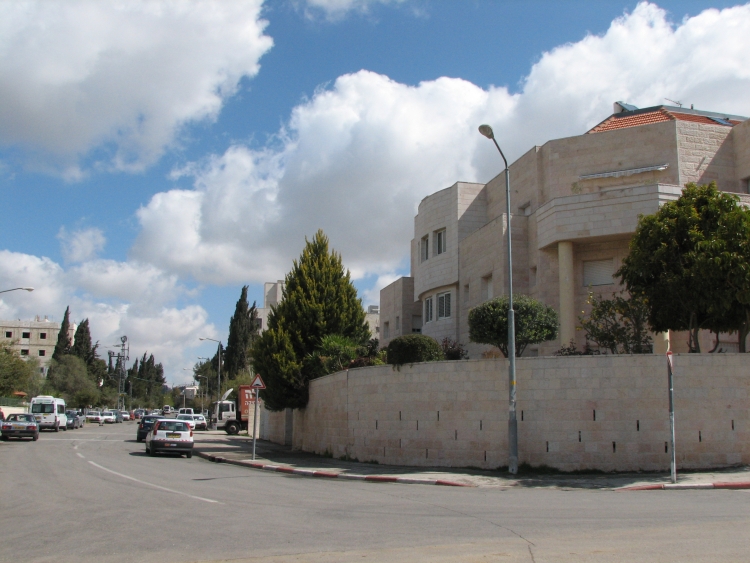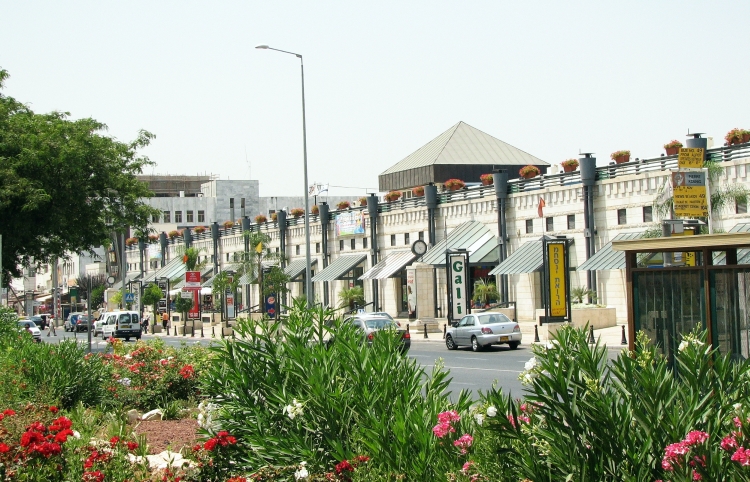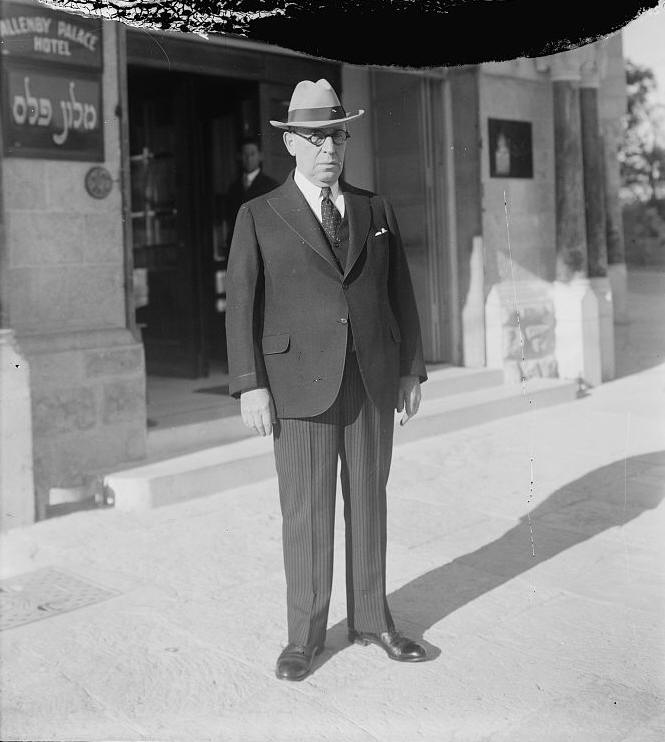|
Mekor Haim
Mekor Chaim (also Makor Haim, he, מקור חיים, ''lit.'' Source of life) is a neighborhood in southwest Jerusalem. It was named for Haim Cohen, a wealthy Jewish businessman who donated large sums of money toward the purchase of land in Jerusalem before World War I. History The funds donated to Hovevei Zion by Haim Cohen were transferred to the Jewish National Fund, which purchased 120 dunams of land on the southern fringes of Jerusalem. Mekor Chaim was established in 1926 by the religious Zionist Mizrahi movement. It was planned as a village of 20 small farmsteads, and was built along one main street which developed parallel to the railway line. Each family received a two-dunam plot for a house, garden and orchard. In the early days, the families had cow sheds and chicken coops. The building contractor, Mar Haim, was head of the first neighborhood committee. He arranged for the Hamekasher bus company to open a regular route between Mekor Chaim and the city center. Initial ... [...More Info...] [...Related Items...] OR: [Wikipedia] [Google] [Baidu] |
Malha
Malha is a neighborhood in southwest Jerusalem, between Pat, Ramat Denya and Kiryat Hayovel in the Valley of Rephaim. Before 1948, Malha was an Arab village known as al-Maliha ( ar, المالحة). History Antiquity Excavations in Malha revealed Intermediate Bronze Age domestic structures. A dig in the Rephaim Valley carried out by the Israel Antiquities Authority in the region of the Malha shopping mall and Biblical Zoo uncovered a village dating back to the Middle Bronze Age II B (1,700 – 1,800 BCE). Beneath this, remains of an earlier village were found from the Early Bronze Age IV (2,200 – 2,100 BCE). According to the archaeologists who excavated there in 1987–1990, Malha is believed to be the site of ''Manahat'', a Canaanite town on the northern border of the Tribe of Judah (Joshua 15:59). Remains of the village have been preserved at the Biblical Zoo. Malha was a Georgian village in the fifth century, in the time of King Vakhtang I Gorgasali, who was canonized by t ... [...More Info...] [...Related Items...] OR: [Wikipedia] [Google] [Baidu] |
Israel State Archives
Israel State Archives (ISA; he, ארכיון מדינת ישראל ''Arkhiyon Medinat Yisra'el'') is the national archive of Israel, located in Jerusalem. The archive houses some 400 million documents, maps, stamps, audio tapes, video clips, photographs and special publications. History The archive was established in 1949 to house historical records of government administrations from the Ottoman era to the end of the British Mandate and document the newly established State of Israel. In 2008, the Israel Museum mounted "Blue and White Pages," a joint exhibit with the Israel State Archives featuring documents relating to the history of the Jewish people from ancient times until the present. In 2012 the headquarters of the archive were closed until further notice after it was found that the building had been operating without the appropriate permit for the previous 19 years. According to a source quoted by Haaretz, obtaining a permit and reopening of the archive will take a matte ... [...More Info...] [...Related Items...] OR: [Wikipedia] [Google] [Baidu] |
Six-Day War
The Six-Day War (, ; ar, النكسة, , or ) or June War, also known as the 1967 Arab–Israeli War or Third Arab–Israeli War, was fought between Israel and a coalition of Arab world, Arab states (primarily United Arab Republic, Egypt, Syria, and Jordan) from 5 to 10 June 1967. Escalated hostilities broke out amid poor relations between Israel and its Arab neighbours following the 1949 Armistice Agreements, which were signed at the end of the 1948 Arab–Israeli War, First Arab–Israeli War. Earlier, in 1956, regional tensions over the Straits of Tiran escalated in what became known as the Suez Crisis, when Israel invaded Egypt over the Israeli passage through the Suez Canal and Straits of Tiran, Egyptian closure of maritime passageways to Israeli shipping, ultimately resulting in the re-opening of the Straits of Tiran to Israel as well as the deployment of the United Nations Emergency Force (UNEF) along the Borders of Israel#Border with Egypt, Egypt–Israel border. In ... [...More Info...] [...Related Items...] OR: [Wikipedia] [Google] [Baidu] |
Haganah
Haganah ( he, הַהֲגָנָה, lit. ''The Defence'') was the main Zionist paramilitary organization of the Jewish population ("Yishuv") in Mandatory Palestine between 1920 and its disestablishment in 1948, when it became the core of the Israel Defense Forces (IDF). Formed out of previous existing militias, its original purpose was to defend Jewish settlements from Arab attacks, such as the riots of 1920, 1921, 1929 and during the 1936–1939 Arab revolt in Palestine. It was under the control of the Jewish Agency, the official governmental body in charge of Palestine's Jewish community during the British Mandate. Until the end of the Second World War, Haganah's activities were moderate, in accordance with the policy of havlaga ("self-restraint"), which caused the splitting of the more radical Irgun and Lehi. The group received clandestine military support from Poland. Haganah sought cooperation with the British in the event of an Axis invasion of Palestine through N ... [...More Info...] [...Related Items...] OR: [Wikipedia] [Google] [Baidu] |
Talpiot
Talpiot ( he, תלפיות, literally 'turrets' or 'magnificently built') is an Israeli neighborhood in southeastern Jerusalem, established in 1922 by Zionist pioneers. It was built as a garden suburb on land purchased by the Tel Aviv-based Palestine Land Development Company and other Jewish building societies. Talpiot has become a major commercial center and a hub of nonprofit organizations. The Talpiot industrial zone is one of the largest in the country, with plans for expansion as a center of shopping, entertainment and industry. Etymology The name ''Talpiot'' derives from a verse in Song of Songs 4:4: "Thy neck is like the tower of David, built with turrets". According to rabbinic sources, Talpiot refers to the Temple. It was said to be a compound of the Hebrew words (hill) and (mouths), as in "the hill to which all mouths turn in prayer". History In the 1920s, the Bauhaus architect Richard Kauffmann presented the British Mandate authorities with a plan for Talpiot, w ... [...More Info...] [...Related Items...] OR: [Wikipedia] [Google] [Baidu] |
Siege Of Jerusalem (1948)
The Battle for Jerusalem took place during the 1947–1948 civil war phase of the 1947–1949 Palestine war. It saw Jewish and Arab militias in Mandatory Palestine, and later the militaries of Israel and Jordan, Transjordan, fight for control over the city of Jerusalem. Under the United Nations Partition Plan for Palestine, 1947 United Nations Partition Plan for Palestine, Jerusalem was to be a Corpus separatum (Jerusalem), ''corpus separatum'' () administered by an international body. Fighting nevertheless immediately broke out in the city between Jewish and Arab militias, with bombings and other attacks being carried out by both sides. Beginning in February 1948, Arab militias under Abd al-Qadir al-Husayni blockaded Jerusalem corridor, the corridor from Tel Aviv to Jerusalem, preventing essential supplies from reaching the Jewish population. This blockade was broken in mid-April of that year by Jewish militias who carried out Operation Nachshon and Battles of Latrun (1948) ... [...More Info...] [...Related Items...] OR: [Wikipedia] [Google] [Baidu] |
Beit Safafa
Beit Safafa ( ar, بيت صفافا, he, בית צפפה; lit. "House of the summer-houses or narrow benches") is a Palestinian town along the Green Line, with the vast majority of its territory in East Jerusalem and some northern parts in West Jerusalem. Since the 1949 agreements, the neighborhood had been divided by the Green Line. Until 1967, the East Jerusalem part remained under Jordanian rule while the northern parts became under Israeli rule. Beit Safafa covers an area of 1,577 dunams. In 2010, Beit Safafa had a population of 5,463. History During the Crusader era, the village was known as ''Bethafava'' or ''Bethsaphase''.Pringle, 1997, pp2829 Baldwin I granted the village as a fief to the Knights Hospitallers sometime before September 1110. A tower in the village is dated to the Crusader period. In the 1360-1370, part of the revenue from Beit Safafa went to the Madrasa ''Al-Manjakiyya''com. on the Haram esh-Sharif in Jerusalem. Ottoman era The village ... [...More Info...] [...Related Items...] OR: [Wikipedia] [Google] [Baidu] |
Mandatory Palestine
Mandatory Palestine ( ar, فلسطين الانتدابية '; he, פָּלֶשְׂתִּינָה (א״י) ', where "E.Y." indicates ''’Eretz Yiśrā’ēl'', the Land of Israel) was a geopolitical entity established between 1920 and 1948 in the region of Palestine under the terms of the League of Nations Mandate for Palestine. During the First World War (1914–1918), an Arab uprising against Ottoman rule and the British Empire's Egyptian Expeditionary Force under General Edmund Allenby drove the Ottoman Turks out of the Levant during the Sinai and Palestine Campaign. The United Kingdom had agreed in the McMahon–Hussein Correspondence that it would honour Arab independence if the Arabs revolted against the Ottoman Turks, but the two sides had different interpretations of this agreement, and in the end, the United Kingdom and France divided the area under the Sykes–Picot Agreementan act of betrayal in the eyes of the Arabs. Further complicating the issue was t ... [...More Info...] [...Related Items...] OR: [Wikipedia] [Google] [Baidu] |
Jerusalem
Jerusalem (; he, יְרוּשָׁלַיִם ; ar, القُدس ) (combining the Biblical and common usage Arabic names); grc, Ἱερουσαλήμ/Ἰεροσόλυμα, Hierousalḗm/Hierosóluma; hy, Երուսաղեմ, Erusałēm. is a city in Western Asia. Situated on a plateau in the Judaean Mountains between the Mediterranean Sea, Mediterranean and the Dead Sea, it is one of the List of oldest continuously inhabited cities, oldest cities in the world and is considered to be a holy city for the three major Abrahamic religions: Judaism, Christianity, and Islam. Both Israelis and Palestinians claim Jerusalem as their Capital city, capital, as Israel maintains its primary governmental institutions there and the State of Palestine ultimately foresees it as its seat of power. Because of this dispute, Status of Jerusalem, neither claim is widely recognized internationally. Throughout History of Jerusalem, its long history, Jerusalem has been destroyed at least twice, Sie ... [...More Info...] [...Related Items...] OR: [Wikipedia] [Google] [Baidu] |
1931 Census Of Palestine
The 1931 census of Palestine was the second census carried out by the authorities of the British Mandate for Palestine. It was carried out on 18 November 1931 under the direction of Major E. Mills after the 1922 census of Palestine. * Census of Palestine 1931, Volume I. Palestine Part I, Report. Alexandria, 1933 (349 pages). * Census of Palestine 1931, Volume II. Palestine, Part II, Tables. Alexandria, 1933 (595 pages). References Further reading * Miscellaneous short extracts from the census reports at Emory University * J. McCarthy, The Population of Palestine, Columbia University Press (1988). This contains many pages of tables extracted from the census reports. {{Authority control Censuses in Mandatory Palestine Census Of Palestine, 1931 Documents of Mandatory Palestine Palestine November 1931 events 1931 documents ... [...More Info...] [...Related Items...] OR: [Wikipedia] [Google] [Baidu] |
1929 Palestine Riots
The 1929 Palestine riots, Buraq Uprising ( ar, ثورة البراق, ) or the Events of 1929 ( he, מאורעות תרפ"ט, , ''lit.'' Events of 5689 Anno Mundi), was a series of demonstrations and riots in late August 1929 in which a longstanding dispute between Muslims and Jews over access to the Western Wall in Jerusalem escalated into violence. The riots took the form, for the most part, of attacks by Arabs on Jews accompanied by destruction of Jewish property. During the week of riots, from 23 to 29 August, 133 Jews were killed by Arabs, and 339 Jews were injured, most of whom were unarmed. There were 116 Arabs killed and at least 232 wounded, mostly by the Mandate police suppressing the riots. Around 20 Arabs were killed by Jewish attackers and indiscriminate British gunfire. After the riots, 174 Arabs and 109 Jews were charged with murder or attempted murder; around 40% of Arabs and 3% of Jews were subsequently convicted. During the riots, 17 Jewish communities were e ... [...More Info...] [...Related Items...] OR: [Wikipedia] [Google] [Baidu] |







